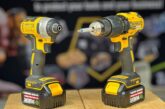
Which areas and what trades are must vulnerable to tool theft? Simply Business reveals the continuing scale of the problem.
In a sign that thieves are becoming increasingly sophisticated, new research has revealed that there has been a notable increase in van break-ins conducted without forced entry, or trace of damage. Often the equipment needed can be bought on the internet relatively cheaply, with the use of an electronic key fob to swiftly unlock keyless entry systems a rising concern. Overall tool theft insurance claims have risen some 54 per cent in the last two years, with the average claim to the value of £1,684.
So just where are tradespeople most vulnerable? The south west has seen the fastest increase in tool theft with an 81 per cent rise, followed by London (67 per cent). The north east has the highest average claim (£2,003), closely followed by East Anglia (£2,005) and south west (£1,979)
With sign written vans, and the vehicle parked outside the job for much of the day, the trades are, of course, particularly vulnerable, as the Simply Business analysis reveals:
The top five affected trades for tool theft:
- Builders – 675 claims
- Carpenters – 357 claims
- Electricians – 258
- Plumbing, heating & ventilation contractors – 223 claims
- Joiners – 214 claims
Top 5 tips for preventing tool theft
- Park against a wall – Aim to park with sliding or rear doors against a wall or sturdy fence so it’s difficult for them to be opened. You should park in busy, well-lit areas, and preferably in view of a CCTV camera.
- Remove tools overnight – Nowadays, a lot of break ins can be from ‘peel and steal’ and electronic key fobs, so even well-secured vans are at risk. If you can, remove tools from your vehicle overnight to completely reduce the risk of losing them, even if an attempt is made.
- Mark your tools – Having identification marks on your tools (e.g. from paint or permanent marker) makes it difficult for stolen tools to be sold on. It also helps to recognise you as the owner if they’re recovered.
- Record serial numbers – Make a note of serial numbers, as well as the make and model of tools you own. Providing this to police in the event of them being stolen will help to identify your tools if they’re found, as well as easing the process of making an insurance claim.
- Make sure you’re insured – Replacing your tools is likely to be expensive. Having insurance in place, whether standalone tools insurance, or as part of your business insurance policy, can help to give you peace of mind as well as support with the sudden financial shock of tool theft. Check your policy and if you don’t already have tools insurance included, consider adding it on. You should also check your policy wording to find out exactly what’s covered, what the limits and excesses are, and if there’s any exceptions to be aware of.







